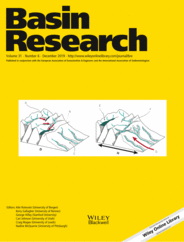
Full text loading...
Apatite fission‐track (AFT) thermochronology and (U‐Th)/He (AHe) dating, combined with paleothermometers and independent geologic constraints, are used to model the thermal history of Devonian Catskill delta wedge strata. The timing and rates of cooling determines the likely post‐orogenic exhumation history of the northern Appalachian Foreland Basin (NAB) in New York and Pennsylvania. AFT ages generally young from west to east, decreasing from ~185 to 120 Ma. AHe single‐grain ages range from ~188 to 116 Ma. Models show that this part of the Appalachian foreland basin experienced a non‐uniform, multi‐stage cooling history. Cooling rates vary over time, ~1–2 °C/Myr in the Early Jurassic to Early Cretaceous, ~0.15–0.25 °C/Myr from the Early Cretaceous to Late Cenozoic, and ~1–2 °C/Myr beginning in the Miocene. Our results from the Mesozoic are broadly consistent with earlier studies, but with the integration of multiple thermochronometers and multi‐kinetic annealing algorithms in newer inverse thermal modeling programs, we constrain a Late Cenozoic increase in cooling which had been previously enigmatic in eastern U.S. low‐temperature thermochronology datasets. Multi‐stage cooling and exhumation of the NAB is driven by post‐orogenic basin inversion and catchment drainage reorganization, in response to changes in base level due to rifting, plus isostatic and dynamic topographic processes modified by flexure over the long (~200 Myr) post‐orogenic period. This study compliments other regional exhumation data‐sets, while constraining the timing of post‐orogenic cooling and exhumation in the NAB and contributing important insights on the post‐orogenic development and inversion of foreland basins along passive margins.

Article metrics loading...

Full text loading...
References


Data & Media loading...

